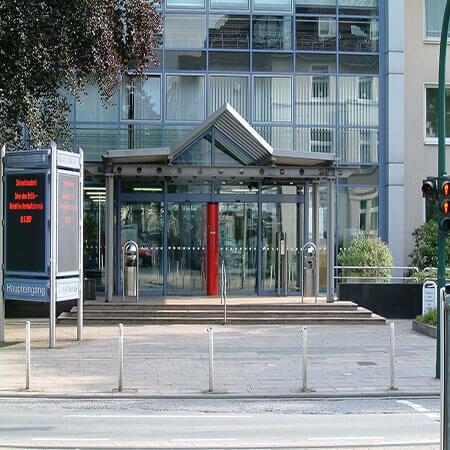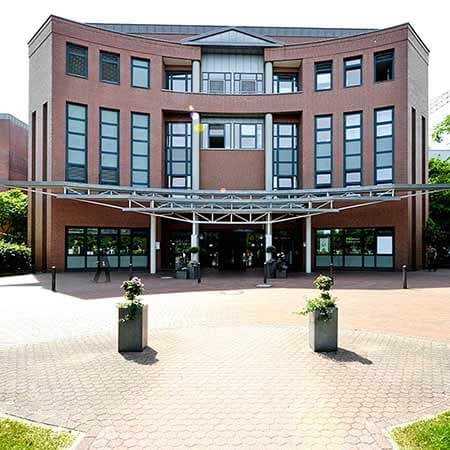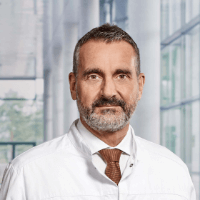Bypass Graft Repair for Aortic Coarctation
Treatment prices are regulated by national law of the corresponding countries, but can also include additional hospital coefficients. In order to receive the individual cost calculation, please send us the request and medical records.

Department of Cardiothoracic Surgery
According to the Focus magazine, the Department of Cardiothoracic Surgery ranks among the top German medical facilities specializing in the surgical treatment of diseases of the cardiovascular system and lung cancer! The department offers the full range of surgical services for the treatment of diseases of the cardiovascular system, respiratory tract, including heart and lung transplantation, artificial heart implantation. The therapeutic options include aortic surgery, coronary artery bypass grafting, transplantation surgery, surgical treatment of heart rhythm disorders (arrhythmias), minimally invasive surgery, surgical treatment of the heart valves, including reconstructive interventions. All operations are performed using state-of-the-art technology and in accordance with the current recommendations of professional societies.






Department of Cardiac Surgery
The Department of Cardiac Surgery provides a full range of surgical treatment in its area of specialization. Special emphasis is placed on heart valve repair and replacement surgery, coronary artery bypass grafting, thoracic aortic surgery, adult congenital and acquired heart disease surgery, pacemaker and defibrillator implantation, and artificial heart implantation for severe heart failure. Many heart operations are performed using minimally invasive techniques, which has a positive effect on the healing of the surgical wound. Minimally invasive cardiac procedures also reduce surgical risks and contribute to a rapid recovery of the patient in the postoperative period. Surgical treatment of cardiac pathologies is performed in advanced operating rooms equipped with the latest technology. The cardiac surgeons of the department successfully perform routine and complex surgical procedures, saving the lives of thousands of patients. The specialists work in accordance with current clinical protocols and follow the recommendations of the German Society for Thoracic and Cardiovascular Surgery (DGTHG).


Department of Cardiothoracic Surgery and Vascular Surgery
The Department of Cardiothoracic Surgery and Vascular Surgery provides effective surgical treatment for diseases of the heart, respiratory system, and blood vessels. The team of cardiac surgeons operates on patients with heart valve pathologies, coronary heart disease, heart failure, and heart rhythm disturbances. In the field of thoracic surgery, the key focus is on the surgical removal of lung tumors and lung metastases. The specialists in this area also perform surgery to repair chest wall deformities. In the field of vascular surgery, interventions for abdominal and thoracic aortic aneurysms are most often performed here. The department's vascular surgeons are also exceptionally competent in the treatment of peripheral occlusive arterial disease. A great advantage for the department's patients is that almost all surgical interventions are performed using minimally invasive techniques, so there is no need for a long postoperative recovery. The department's operating rooms are equipped with state-of-the-art technology. This allows for effective and safe treatment. The priority is always personalized medical care for patients.






Aortic coarctation is one of the most common heart defects, accounting for up to 7% of all cases. The disease is often severe, causing critical hemodynamic disorders in patients shortly after birth. If hemodynamic compensation occurs, severe complications will develop after the age of 20-30 years. Every case of coarctation of the aorta requires treatment to restore normal circulation. The earlier it is performed, the better the results. You are welcome to use the Booking Health service to undergo your treatment abroad or find out the cost of treatment at a hospital abroad. On our website, you can compare prices at different hospitals and get services for organizing your trip to a foreign hospital.
Content
- What is aortic coarctation?
- What is a bypass graft repair for aortic coarctation?
- When can a bypass graft repair for aortic coarctation be performed?
- How is a bypass graft repair for aortic coarctation performed?
- Benefits of a bypass graft repair for hemodynamic restoration in aortic coarctation
- Where to undergo your aortic coarctation treatment?
What is aortic coarctation?
Coarctation of the aorta is the narrowing of this blood vessel. This can be localized anywhere but is most often found in the ductus arteriosus.
The disease is characterized by severely impaired hemodynamics, since too little blood passes through the narrowed section of the aorta into the systemic circulation. Over time, a partial recovery of hemodynamics occurs due to the expansion of coronary collaterals, which are bypass routes for blood flow. However, comprehensive recovery does not occur, so all patients with coarctation, without exception, need surgery.
If left untreated, coarctation causes severe complications. These may be ventricular dysfunction, brain aneurysms, severe arterial hypertension, or early coronary heart disease.
What is a bypass graft repair for aortic coarctation?
Bypass grafting is an operation to form a bypass, which is an additional blood vessel through which blood flows around the area of narrowing of the aorta. Doctors perform blood vessel grafting from another part of the body. During the grafting procedure, the blood vessel is fixed above the narrowing with one end and below the narrowing with the other.
At hospitals abroad, such a grafting procedure can be performed without the use of a heart-lung machine. During the bypass graft repair, it also does not matter what condition the aorta and its arch are in or whether there are adhesions in the thoracic cavity because the operation can still be performed successfully.
A bypass graft repair was first performed in 1973. The technique was developed to reduce the risk of complications. This surgery is indeed one of the safest for a patient. In the original version of the surgical intervention for the treatment of coarctation, the bypass started from the aortic arch and flowed into the descending aorta. This bypass graft repair is called an aorto-aortic bypass.
Based on the results of the blood vessel grafting and the formation of an aorto-aortic bypass, complete hemodynamic recovery occurs. After recovery, patients can lead a full and active life without any restrictions. The quality of life increases and its duration increases due to the prevention of complications of aortic coarctation and improved control of arterial hypertension.
When can a bypass graft repair for aortic coarctation be performed?
A bypass graft repair to restore hemodynamics is not very common in hospitals abroad. Basically, this operation is performed on adult patients with coarctation.
Bypass grafting is not one of the main methods of restoring hemodynamics in patients with aortic coarctation. Doctors at most hospitals prefer to perform end-to-end anastomosis, aortic replacement surgery, or balloon angioplasty with stenting. However, in some cases, an aorto-aortic bypass is still used. Basically, blood vessel grafting to form a bypass blood flow path is performed in the following cases:
Recurrent coarctations of the aorta. If a patient has previously undergone surgical treatment but has experienced recurrent blood vessel narrowing, a bypass graft repair is performed.
Adhesions at the site of the surgical intervention. Adhesions may develop both after operations for heart defects and after any other surgical interventions. They interfere with the necessary manipulations. Therefore, in such a case, an aorto-aortic bypass is a technically simpler solution to restore blood flow, as well as more successful.
An atypical localization of the narrowed site. For example, if the coarctation area is located in the descending thoracic aorta or in the abdominal aorta.
A rather long length of the narrowed site. A bypass graft repair may be performed as an alternative to an aortic prosthetic repair. However, prosthetic repair surgery is more common.
A high risk of brain damage. A bypass graft repair can be performed without clamping the carotid arteries or using a heart-lung machine. Therefore, the technique is suitable for the treatment of patients in whom prolonged depletion of the cerebral blood flow is unacceptable due to the high risk of cerebral complications.
How is a bypass graft repair for aortic coarctation performed?
The operation is performed using open techniques. Surgical approaches may be different. Surgeons may make an incision in the center of the chest, on the lateral surface of the chest on the left, or on the right. Most often, a right-sided thoracotomy is performed when an incision is made between the ribs on the right.
A bypass graft repair may be performed with or without the use of a heart-lung machine. In general, surgeons prefer to perform the operation without connecting a patient to the heart-lung machine to reduce the risk of complications. The possibility of avoiding its use is one of the main advantages of bypass grafting as compared to other operations for aortic coarctation repair.
The incision is usually made in the fifth intercostal space. A doctor opens the pleura, retracts the lung upward and anteriorly, and highlights a segment of the aorta about 10 centimeters long. The right intercostal arteries are ligated. Doctors implant the lower end of the vascular prosthesis and check its tightness. The lung is then retracted down and back, the pericardium (pericardial sac) is dissected, the ascending aorta is isolated, and the upper part of the graft is placed.
Upon completion of the operation, the clamps are removed, and blood flow in the aorta is restored. Doctors close a surgical wound by suturing it. For several days, tubes remain in the wound to drain fluid from the pleural and pericardial cavities.
Benefits of a bypass graft repair for hemodynamic restoration in aortic coarctation
The bypass grafting technique is less common as compared to other hemodynamic restoration surgeries for aortic coarctation. However, it has benefits that allow this treatment option to remain in the arsenal of surgeons for half a century. The main ones are:
- because aortic parietal pressing is not required, cerebral circulation is not impaired (there is a low risk of neurological disorders after surgery);
- the aorta is not dissected in the area of degeneratively altered walls;
- there is not even a minimal likelihood of some complications that are inherent in other types of operations, such as damage to the recurrent laryngeal nerve, intercostal arteries, or lungs;
- the absence of complications from the spinal cord;
- the operation can be performed without the use of a heart-lung machine, so complications associated with its use (systemic inflammation or damage to blood cells) do not develop;
- a less traumatic surgical approach shortens patients' recovery time and makes the postoperative period easier;
- during a bypass graft repair to restore blood flow in coarctation, simultaneous release of the esophagus and trachea in the case of their compression can be performed, if required.
Where to undergo your aortic coarctation treatment?
You can undergo your treatment abroad. There are a few reasons for you to go abroad. These are the following:
- in developed countries, operations for aortic coarctation are effective and safe;
- hospitals abroad have state-of-the-art equipment;
- doctors use the latest modifications of surgeries;
- operations are performed through minimally traumatic surgical approaches and without a heart-lung machine;
- successful interventions are performed even in complex cases: in significant degenerative changes in the aorta, concomitant aortic arch hypoplasia, adhesions in the chest cavity, and secondary pathologies of the cardiovascular system;
- after the operation, you will be able to undergo full rehabilitation to return to your normal life in a short time.
You are welcome to use the Booking Health service to undergo your treatment abroad. On our website, you can see the cost of treatment, compare prices, and choose a medical care program. When you make an appointment at the hospital through Booking Health, the cost of treatment abroad will be lower for you. Prices are reduced due to the absence of additional taxes for foreign patients. In addition, you can be sure that the initial cost of treatment will not increase after the start of your medical care program. You will receive insurance that will cover unexpected medical expenses.
The Booking Health specialists will organize your treatment abroad. We will contact the hospital administration, make an appointment on your preferred dates, translate and send your medical documents to the hospital, and book the nearest hotel and airline tickets. Our company's employees will meet you at the airport and take you to the hospital by car. After the completion of your treatment abroad and recovery, a return transfer from the hospital to the airport will be organized.
Authors:
The article was edited by medical experts, board-certified doctors Dr. Nadezhda Ivanisova and Dr. Vadim Zhiliuk. For the treatment of the conditions referred to in the article, you must consult a doctor; the information in the article is not intended for self-medication!
Sources:
European Society of Cardiology

